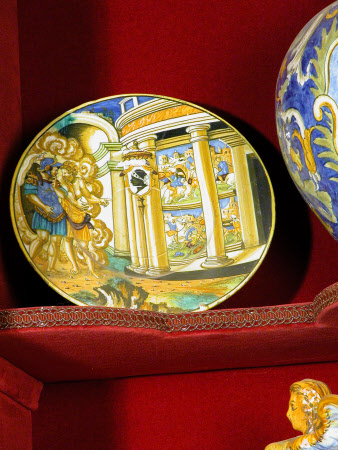Dish
Francesco Xanto Avelli (c.1487 - c.1542)
Category
Ceramics
Date
1532
Materials
earthenware, tin-opacified lead glaze, polychrome pigments
Measurements
274 mm (Diameter)
Place of origin
Urbino
Order this imageCollection
Knightshayes Court, Devon
NT 540390
Summary
Dish from the Pucci Service, earthenware with tin-glaze (maiolica), painted by Francesco Xanto Avelli, Urbino, Italy, dated 1532; painted with Aeneas contemplates the Trojan, from Virgil’s Aeneid, Book 1, depicting Aeneas studying a mural of the Trojan war on the walls of Juno’s temple in Carthage built by Dido, elements of the scene derive from the prints of Marcantonio Raimondi after Raphael, in the centre is the arms of the Pucci family of Florence, (argent, a moor’s head proper wearing a headband argent charged with three hammers sable, behind the shield, an ombrellino); the underside inscribed with the date, subject, literary source and artist’s name, ‘1532 | Le Battaglie Troiane Enea | contempla vel . I . librio de l’Eneida. v. | f. xanto. A. | da Rorigo, | Urbino.’ [Trans. The Trojan war contemplated by Aeneas from the first book of the Aeneid, Francesco Xanto Avelli of Rovigo, Urbino].
Full description
From the early 16th century, the market for luxury table wares was stimulated by demand from the nobility and wealthy merchants in Italy, and as far away as Germany, for use on their own tables or as diplomatic gifts. The variety of shapes, based on costly silver or gold, suggests that the vessels were for use. It was common practice to eat with one’s fingers and occasionally forks, which did not scratch the glaze, the usual indicator of use, although it is also thought these wares were only for display. This dish, painted with the arms of a member of the aristocratic Florentine Pucci family, dated 1532, is one of 36 dishes and plates, as well as a salt, identified from this ambitious service made between 1532 and 1533. It is the largest set painted by Franceso Xanto Avelli to survive, and was perhaps made for either Roberto Pucci (1463-1547), or Cardinal Antonio Pucci (1485-1544), although unusually, the ombrellino symbol has replaced the cardinal’s cap in the arms. The Knightshayes dish is listed among the 420 signed or attributed works of art by Xanto recorded in J.V.G. Mallet, Xanto: Pottery-Painter, Poet, Man of the Italian Renaissance, Wallace Collection (London, 2007), Appendix C, no. 177, ‘Plate, Aeneas contemplates the Trojan Battles, …published in Jörg Rasmussen, The Robert Lehman Collection: 10, Italian Maiolica, Princeton and New York, 1989, Appendix I, no. 80.30.’ There were five pieces with the signature of Francesco Xanto Avelli, including this dish, in the collection formed by Revd. Thomas Berney (1816-1895), whose family were wealthy Norfolk gentry. This dish was only mentioned in B. Rackham, ‘The Berney Collection of Italian Maiolica’, The Burlington Magazine for Connoisseurs, Vol. 61, No. 356 (November 1932), p. 214, although some of the others were illustrated. Berney lent this dish and 18 others to the Special Exhibition South Kensington, 1862, cat. no. 5246 (see J.C. Robinson (ed.), Catalogue of the Special Exhibition of Works of Art of the Mediæval, Renaissance, and More Recent Periods, On Loan at the South Kensington Museum June 1862, No. 5,246). His collecting taste was probably influenced by the important collection of Italian maiolica owned by Andrew Fountaine (1808-1874) of Narford Hall, Norfolk, the brother of his wife Caroline. This historic collection was formed by their ancestor, also Andrew Fountaine (1676-1753), an antiquarian and amateur architect: his collection was sold in 1884 (see Timothy Wilson, Italian Maiolica and Europe: Mediaeval and Later Italian Pottery in the Ashmolean, Museum (London, 2017), p. 137). While many of the items in Berney’s collection were damaged, and probably less expensive, he clearly was collecting with the eye of a connoisseur. For a discussion of the print sources derived from Marcantonio Raimondi’s prints after Raphael, see Julia Triolo, The Armorial Maiolica of Francesco Xanto Avelli (Unpublished doctoral thesis), UMI Dissertation Services, Ann Arbor, 1996, pp. 297-341, p. 302, 7.4, and Triolo, Julia. ‘Francesco Xanto Avelli’s Pucci Service (1532-33)’, Faenza, part one 74:1-3 (1988), pp. 37-40 & part two 74:4-6 (1988), pp. 232-34. From the large collection formed in the mid-19th century by the antiquarian Reverend Thomas A. Berney (1815-1895), of Bracon Hall, Norfolk; by descent to Miss Berney, sold at Sotheby & Co., London, Catalogue of Fine Italian Majolica, 18 June 1946,18 June 1946, the first of two items in lot 20, ‘An Urbino Armorial Plate, by Fr. Xanto, from the Pucci service, with Aeneas looking at the paintings of the Trojan War on the walls of Dido’s palace, 10 ¾ in., signed and dated 1532; and another Plate, painted with Aesculapius killed by the thunder of Jupiter, 10 ½ in., circa 1540. The lot purchased for 30 guineas (£31.10s.0d.) at the Berney sale by "Sir J Amory", Sir John Heathcoat-Amory (1894-1972), 3rd Bt., of Knightshayes Court; the house, part of the collection, the garden Sir John and Lady Heathcoat-Amory created, and part of the estate were bequeathed to the National Trust by Sir John Heathcoat-Amory in 1972. The maiolica was later given by Joyce, Lady Heathcoat-Amory (1901-1997), née Wethered, a celebrated golfer.
Provenance
ex Bemey (?) Sale, Sotheby's, 18 June 1946. The dish was part of a S(?)amons service made by Francesco Xanto Avelli in 1532 for Pier Maria Pucci From Lady Amory
Marks and inscriptions
1532 Le Battaglie Trione Enea/contmpla, vel. l. Libro de l'Eneida.v.f Xanto.A. da Rovigo, Urbino
Makers and roles
Francesco Xanto Avelli (c.1487 - c.1542), painter
